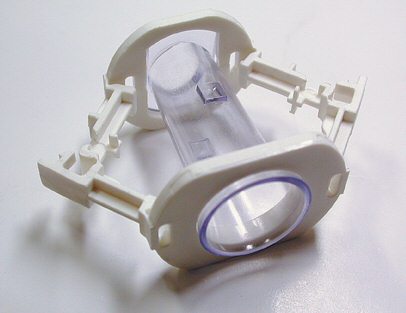Methods of circumcision
-Herman Melville, Moby Dick
Tribal Tribal circumcision has its own page. The commonest method is to pull out the foreskin and chop with a spear or slice with a knife against some hard substrate. The terror and pain of this seems to be part of its appeal (to the adults), and accidents will happen.  Abraham and Ishmael are circumcised, from the Egerton Genesis Picture Book, 14th century British Library 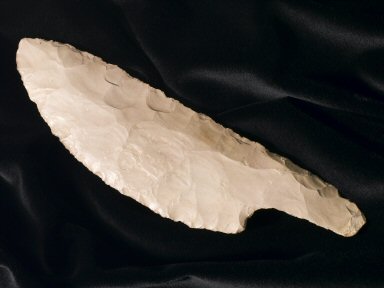 Flint knife from Egypt
Barzel and Izmel The izmel (Hebrew for scalpel) is a double-bladed knife, to ensure that a nervous mohel can not choose the wrong side and thereby cause (additional) pain to the baby. You might think that the wrong side could be marked, coloured or otherwise indicated quite easily, reducing both that risk and the risk of cutting some other part of the baby or the mohel himself with the back blade.  The barzel (Hebrew for iron) also known as a mogen (Hebrew for shield) s a slotted shield to protect the glans, which it may or may not do, depending on the glans' size and conformation. This one is gold-plated silver. 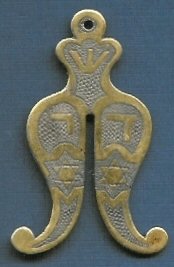 Forceps guided A basic surgical method before the invention of the various medical clamps - widespread in the British Commonwealth when it was still believed to do some good. The foreskin was pulled through a pair of bonecutters, 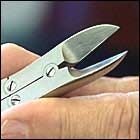 which (usually) protected the glans, and the exposed foreskin cut along the clamp's edge.
Sleeve resection Two circular cuts and one lengthwise one are made in the shaft and a cylinder of skin is removed, then the cut ends pulled together and stitched. The outcome depends on where along the penis the cuts are made, and how far apart they are. In Japan, though it is rarely done at all, proximal cuts (close to the body, are reportedly favoured, keeping the inner mucosa and ridged band, but possibly interfering with their innervation. 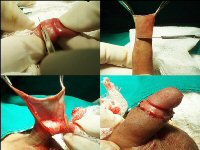 Click on the image for larger (NSFW) This image is from a study that found 10 immediate and 8 late complications, and 20 adhesions, in 68 sleeve circumcisions.
Scissors When non-religious circumcision of adults became a commonplace, Sir Frederick Treves used scissors.  The problem with using no clamping method was, how to keep even tension on the foreskin to give a straight cut? As the cut proceeds, the same amount of tension is concentrated in less and less skin, "so the incision at the frenulum was often deeper and uneven." (Grossman)
Ecraseur In Paris in 1920, Doyen used what he called an écraseur or crusher on both adults and babies. 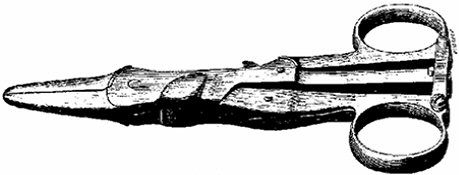
Circumcision forceps Invented by a Dr Moskovich in 1920, apparently for adult circumcision, but they look more as though they should be used to blow bubbles.  The top ring was introduced into the preputial cavity - somehow - and the foreskin fanned out between the two rings. After cutting round it, seven sutures could be made in the notches. It had the obvious problem of the place where the forceps attach to the rings. The rings also left a collar of skin round the glans. Less obvious, it can't apply much pressure over so large an area, but it was the first circumcision device to acknowledge that the prepuce is, more or less, circular.
Harris Clamp The Harris Clamp (1932) certainly didn't consider the actual shape of the foreskin. It looks as though you'd need two thumbs to work it.  The third arm, C, drives a blade up through a slit in both the haemostat arms. The problem with that is that the blade gets blunt with repeated use.
Gomco™ clamp A device invented in 1934 by Hiram S. ("Inch") Yellen, M.D. and Aaron A. Goldstein (and reportedly based on the tyre-lever used for Model T Fords, according to Julian Wan's sickeningly worshipful history of the device). It consists of a metal bell placed over the glans (requiring a slit in the foreskin first) and a flat plate with a hole in it placed over both, to define the position of the cut. They are brought together by a screw to apply circular crushing and fusing force (of 8000 to 20,000 pounds, according to Wan) at the position of excision. It leaves a characteristic dark line at the excision scar.
Varney's Midwifery says its disadvantages are that "it involves more parts, requires more steps in the procedure, and it takes more time." Under that enormous pressure, a groove wears in the bell with prolonged use, making it ineffective. The clamp is made in a set with different-sized bells and rings and there is a danger of mixing parts of different sizes. In 2001, the FDA issued a warning against clamp injuries. A video for the rival Accu-circ demonstrates how these injuries can occur. In 2009, Dr David Tomlinson endeavoured to reduce this risk by adding coded holes to the lever and corresponding studs on the plate, and differently sized shafts on the bells, matched to differently sized notches on the lever. 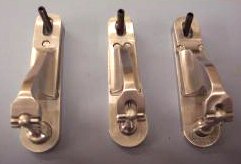 The bell has been found to develop grooves and nicks following repeated use with surgical blades. There have been reports of the bell breaking where it presses against the baseplate as pressure is applied. A ring of metal breaks off and is left inside the preputial cavity and the clamp is rendered useless. There have also been reports of glans injury if the scalpel cuts through the bell. The Gomco can obviously not be left on the penis, in fact it is removed as soon as the skin is cut off, giving a risk of bleeding. Nutech Clamp This is even more true of its offspring, the Nutech Clamp invented by Rabbi Harry Bronstein, which looks like a hacksaw, but is actually held the other way around: 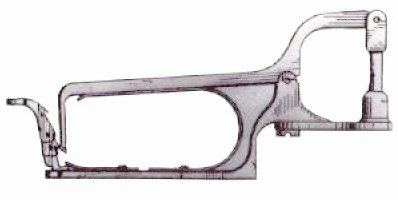 Winkelman clamp The Winkelman clamp, invented in 1935, lost the leverage of the Gomco but provided a large wingnut instead. It was still in use in Palestine in 2012. 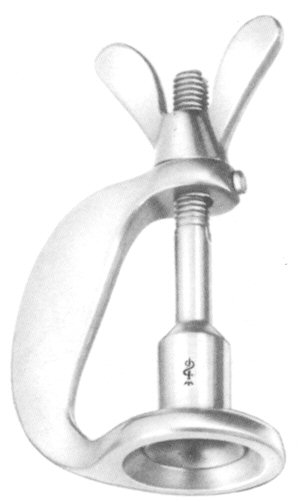 Circumstat A more obvious descendent of the Gomco is the Circumstat, invented by Rabbi Irving Grossman in 1962. 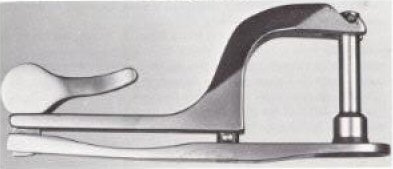 The cam is apparently quicker and simpler than the screw of the Gomco. Tibone Clamp The Tibone clamp of 1944 lost the leverage provided by the Gomco without the compensating wingnut of the Wiinkelman, and was more awkward to fit. Also, says Grossman, the side arm of the C was too close to the bell, and got in the way of the scalpel. The device never gained any popularity. 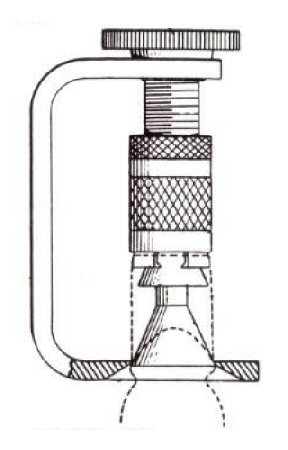 Improved Bloodless (Maryan) Clamp Another variant on the Gomco was the Improved Bloodless Circumcision Clamp invented by a Dr H O Maryan in 1954:  This had three interchangable bells, and supported the screw on a tiny lintel, like an early printing press, that pulled instead of pushing. Turner clamp So did the Turner Clamp of 1952, but it is operates in the reverse direction, the bell crushing the prepuce down on the aperture. 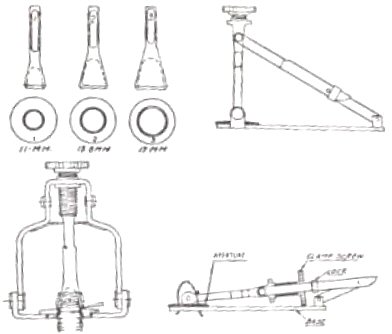 Both had the problem of the Tibone times two, the supports of the bell getting in the way of the scalpel on both sides. Neither eclipsed the Gomco. Preputome A cross between the Circumcision Forceps and the Gomco was the Preputome, invented in 1945 by a Brooklyn doctor called Al Akl. 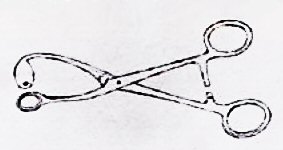 (It was not actually a preputome, because it didn't cut. A better name would have been "prepustat".) It thoughtfully provided a hole through which the baby could urinate on the doctor. Since the bell pressed the glans downward, it could wedge some of the corona against the ring as the clamp was closed, allowing it to be cut along with the foreskin. The Preputome never became popular (especially not with babies). Leff clamp Flat clamping continued with the Leff Clamp, invented in 1950, which looked like, and worked like, a large paper clip, used in conjuction with a barzel. 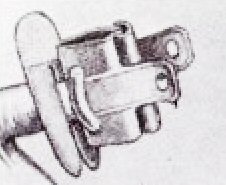 Sheldon clamp™ It led to the first incarnation of the Sheldon Clamp, in which the spring was augmented by a screw in order to achieve haemostasis. This had the obvious problem of awkwardness in making the cut, but apparently for Sheldon, the problem was not enough pressure, and the Return of the Sheldon applied pressure with leverage similar to a vicegrip clamp. Rathmann FGC clamp
Sheldon clamp II The first of its two pairs of flat jaws grasps the acroposthion, the second set, the foreskin proper, ahead of the glans - if the boy is lucky. A straight cut is made between the two sets, resulting in a low circumcision similar to the tribal cut. Making the operator slice into a small aperture in the instrument almost guarantees an awkward cut. The Sheldon Clamp has reportedly been withdrawn because of lawsuits, but was still in use as late as 1994.  Sheldon Clamp (showing how glans can be damaged) The design seems simply unfortunate; it's hard to understand how it ever left the drawing- board. Kantor clamp In 1953, a Texas physician called Kantor merged a haemostat with a barzel. Its linear cuts, as with all linear devices, resulte in crushed "dog ears" at the front and back of the penis. Mogen clamp In 1954, Rabbi Harry Bronstein, a Brooklyn mohel who'd previously invented the Nutech clamp - that's the one that looks like a hacksaw - invented the Mogen clamp. Mogen means shield (and in fact what we call in English the Star of David is Mogen David in Hebrew, the Shield of David.) It resembles a barzel, but one whose two blades are hinged together, and brought together with a cam.
This is a step backward to straight-line cutting, but mohels like it because it's quick and resembles the traditional method. Unlike the barzel, it closes to crush the foreskin before it is cut. Described as "the least painful method" though there is no reason this should be so, and "able to be used without previous experience." With the glans below and completely out of sight, it can be trapped in the locked slit. And as Grossman points out, the meatal lips often project from the glans and into the clamp. It opens no wider than 3mm in order not to admit the glans - but it is not possible to see whether this has in fact happened: Varney's Midwifery - in a chapter written by a mohalet - says 'Using the Mogen clamp has the distinct disadvantage of making the circumcision a "blind" procedure. The glans of the penis cannot be seen (so anomalies may not be discovered until after the circumcision) and is thus at risk of being cut.'
Glansguard A doctor called Melges invented the Glansguard as late as 1972. It resembles a kitchen bag-sealer. 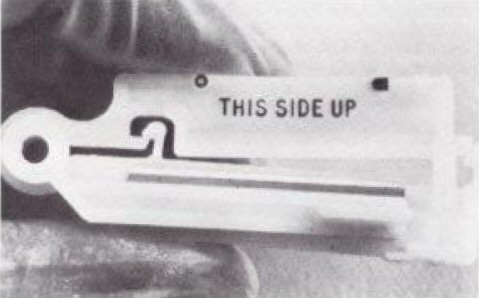 It has a built in knife. It doesn't guard the glans, especially when it's put on upside down, hence the clear message, "This Side Up".
Ross Rings The first of the tourniquet devices was the metal Ross ring. 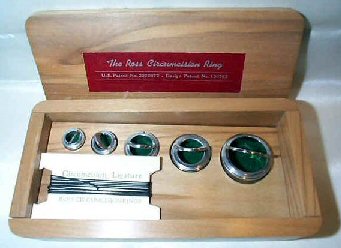 In five sizes (reusable, as the handsome art deco walnut case implies), it included one groove for the ligature and one to catch the scalpel as it cut off the foreskin. 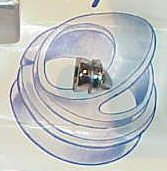 Its tiny handle was on an angle, perhaps to align with the axis of the penis and follow the line of the sulcus. But in that case the small notch on the outside is on the wrong side to accommodate the frenulum, as one commentary suggests. (Its purpose may actually be to facilitate the knot.) An enclosed leaflet reportedly "Says the device is to be left in place for 24 to 72 hours."
Plastibell™ Come the 1950s, plastics and the age of disposables, and the Plastibell - developed out of the Ross Ring in 1950 - became the method of choice. Like the Gomco, it requires a dorsal slit and tearing of the foreskin from the glans before it can be fitted. 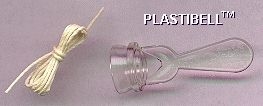 Then the foreskin is pulled up over the bell, and the ligature tied to crush it into the groove. Everything distal to the ligature dies, and to stop this upsetting parents too much, it may be cut off first. A grooved plastic dome (with a handle, designed to be broken off) placed under the foreskin (which must be slit and forcibly separated from the glans to allow entry). A ligature (thread) is tied tightly around the foreskin, crushing it into the groove, causing it to become necrotic (to die) and drop off. Varney's Midwifery, citing Gee and Ansell, says "the Plastibell has a higher incidence of infection." Mothers supporting circumcision in the Moms Online pages reported several complications of Plastibell circumcisions in January 2001, for example:
One study of 2000 PlastibellTM circumcisions found a complication rate of 1.8%, "the most frequent being minor infection and hemorrhage. Other complications included a tight Plastibell ring that can cause constriction of the glans penis, irregular skin margin, inadequate skin excision and migration proximally [up the penis] of the Plastibell ring as the glans swells with venous engorgement. There have been isolated cases of necrotizing fasciitis, ruptured bladder, retention of urine secondary to glandular prolapse, and retention of the Plastibell device.
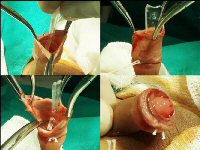 Click on the image for larger (NSFW) This image is from a study that found 3 immediate and 3 late complications, and 6 adhesions, in 57 Plastibell™ circumcisions.
"Improved" Plastibell Dr David Tomlinson's "improved Plastibell" of 2009 added
 Tomlinson et al. report testing the improved Plastibell on 85 babies and the knife on five. It does not seem to have gone into production. Its main interest is as a precursor of the Accu-circ
Sunathrone The Sunathrone, made in Malaysia, described as "the Superb Bio-Engineering Innovation Envisioned and Derived from Aerospace Technology" offers "non-invasive circumcisions" - which would be quite a feat. It replaces the suture of the Plastibell with a hard outer clamp that is applied with a plier-like device called a Sunalever and locks shut like a handcuff. The chess-queen-like cone is broken off after the foreskin has been cut away. 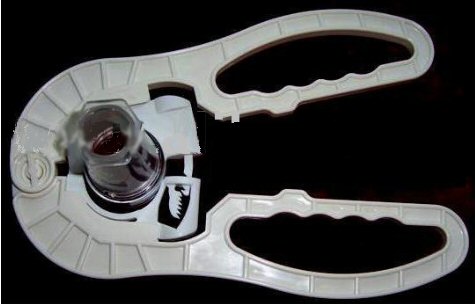
Tara KLamp™ A non-reusable circumcision device made of plastic. Works by cutting off circulation to the foreskin, using a plastic ring clamped in place over a tube (to allow urination). Available in sizes up to adult, recently developed in Malaysia. (Capital, Kuala Lumpur = K.L., hence KLamp) 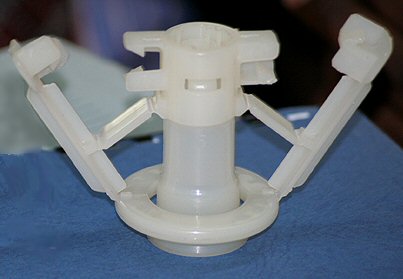
A non-reusable circumcision device made of plastic, similar to the Tara KLamp. Works by cutting off circulation to the foreskin, using a plastic ring clamped in place over a tube. Available in sizes up to adult.
Ali's Clamp Ali's clamp is the only devide to recognise that the cut is on an angle to the axis of the penis, and hence not circular.  It makes the slightly less inaccurate simplifying assumption that the penis then has an elliptical cross-section.
Ismail Clamp The Ismail clamp uses a screw to apply pressure instead of levers. 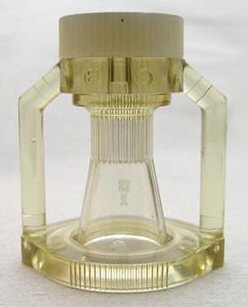 It claims to be "readily removable" which means it can be re-used, with a risk of cross-contamination.
Zhenxi Rings 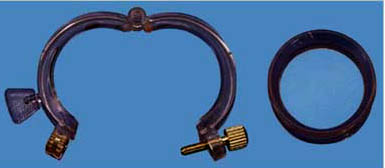 A grooved sleeve is passed over the glans to sit just behind the corona. The foreskin is replaced over this sleeve. A hinged plastic clamping ring is fitted over the sleeve, the position of the foreskin is adjusted and the nut tightened to hold the foreskin in place. An elastic cord is then wound tightly around the penis, compressing the foreskin into the groove of the sleeve below it. This cuts off the blood supply and the foreskin forward of it dies and falls off. The glans and frenulum are protected so the frenulum remains intact. The result is expected to be moderately tight, depending on the adjustment before clamping. The resemblence between this device and the next one is only superficial. The Zhenxi is a tourniquet (strangulation) device...
Shang-ring™ A haemostasis (bleeding-prevention) circumcision device named after its inventor, Jian-Zhong Shang, consisting of two concentric plastic rings that "sandwich" (unfortunate expression) the foreskin, allowing it to be cut away without suturing and with reduced bleeding. In this it apparently resembles the Tara KLamp, Smartklamp and the like. Its makers claim that in a clinic under local anesthesia, circumcision takes less than five minutes. The patient must wear the device for a week. Currently available only in China, but being tested in Kenya. Not FDA approved.  Video of a Shang-ring circumcision (NSFW)
PrePex Very similar to an Elastrator, the PrePex system cuts off circulation and kills the foreskin with an elastic ring that crushes it into a grooved ring. Claimed to be bloodless and not to require anaesthetic or a sterile environment. Being tested in Rwanda in 2011. (HIV prevalence in 2005: non-circumcised 2.1%, circumcised 3.8%) 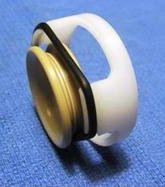
Kirve Clamp The Kirve clamp resembles the Shang ring, but with a placement device with a handle and a bayonet fitting so that it can be removed from the inner ring after placement and cutting. 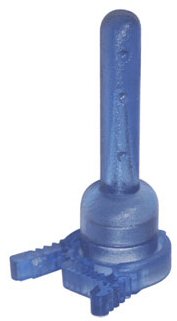 Kirve is Turkish for "uncle".
Accu-circ™ The Accu-circ is radical in several ways. It's disposable, self-contained and does everything. It reverts from crushing and necrosis to clamping and cutting. It's annular, but still assumes the penis is circular, and makes no provision for the frenulum. It resembles a cork puller.
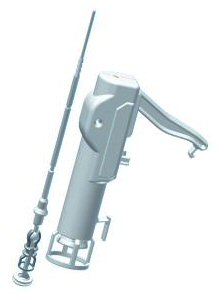 The blunt probe (top centre) that tears the synechia, to separate the foreskin from the glans, has at its other end (bottom left) a broken ring-shaped chopping block that can be slid inside the foreskin without a previous dorsal slit. A tiny circular end-on clamp is slid down the probe. The main device (right) is then slid down the probe and locked in place, and a circular blade cuts the foreskin. The manufacturers call it "atraumatic". Tell that to the baby having his foreskin torn away from his glans. The streaming video originally promoting this device was notable for its lush orchestral music instead of the actual sound of the shrieking baby. After the probe has torn the foreskin from the glans, the ring is twirled into the foreskin, and the "shielding ring" brought down on to the circular anvil to hold the foreskin in place. But it's still a blind procedure with no guarantee that the glans will stay out of harm's way.
What happens to the frenulum with the Accu-circ is very much a matter of chance, depending on what the blunt probe did, and where the frenulum ends up, between the inner ring and the outer. The Accu-circ has been cleared by the Food and Drug Administration for use in the US, on babies up to ten days old, on the basis that it is "substantially equivalent … to legally marketed … devices" but in fact it is radically different.
The inventor, Tomlinson, has treated circumcision as if it were a kitchen chore like crushing garlic, and invented a device to do it like that. But garlic doesn't die, and it doesn't sue.
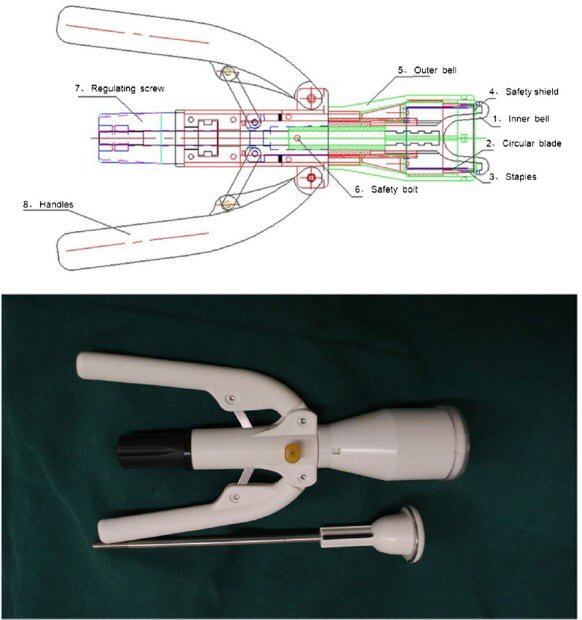 A study of 441 men cut with the stapler
compared with 438 cut with an electric scalpel
for "redundant foreskin or phimosis" in four Chinese
hospitals found
the stapler was faster, healed faster, and caused less blood
loss, pain
and complications, with more patient satisfaction - but at a
higher cost - than
the scalpel method.
 The Novadien website (which relies heavily on the work of Professor Brian Morris) offers an animated video of the operation. Solehring The Solehring, invented in 2017 by Dr Mohamad Salleh Abdul Aziz of Cyberjaya University, Malysia, is similar to the Plastibell, but with a separable dome in an attempt to protect the glans until the foreskin has been crushed by a cord and severed. The ring typically falls off after 10-14 days. One serious complication has been reported. 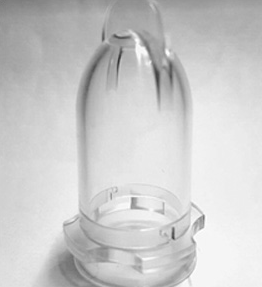
Timeline 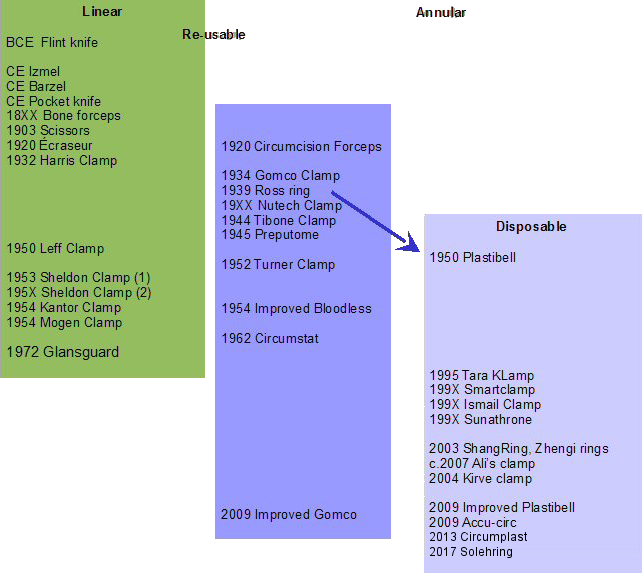
Reference The evolution of these circumcision methods is discussed in a chapter in Genital Cutting: Protecting Children from Medical, Cultural, and Religious Infringements ed. Denniston, G C, Hodges, F M and Milos, M F, pub. Springer (2013) |
![Gomco clamp [TM]](Images/methods/gomco.jpg)
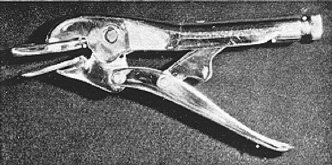
![Mogen[TM] clamp](Images/methods/mogen.jpg)
